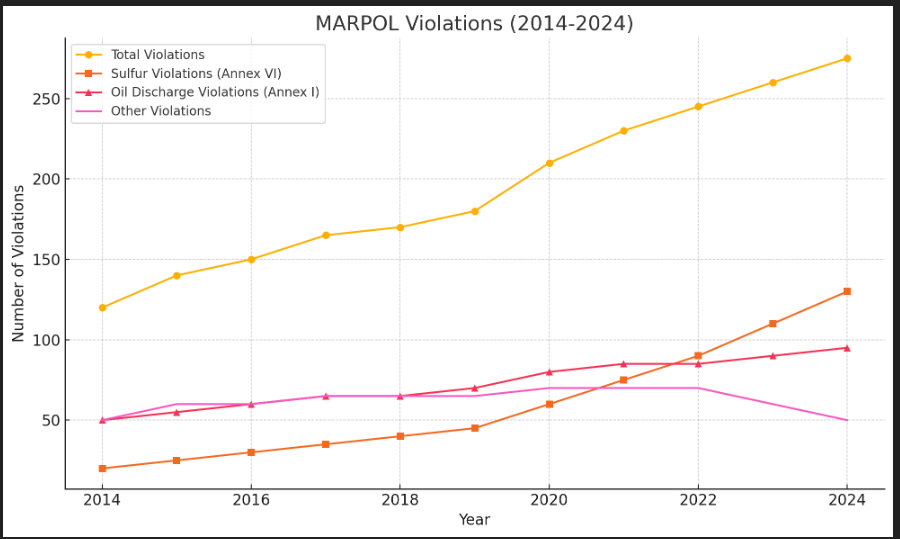Environmental Performance of the Shipping Industry: A Case Study of MARPOL Violations
DOI:
https://doi.org/10.62012/collaborate.v2i2.66Keywords:
MARPOL, shipping industry, environmental performance, sulfur emissions, port state control, regulatory enforcement, pollution control technologiesAbstract
Focusing on key areas such as sulfur emissions under MARPOL Annex VI, oil discharge violations, and other pollution infractions, the research explores trends in non-compliance, the geographical distribution of violations, and the effectiveness of regulatory enforcement. The results reveal a significant increase in sulfur violations following the introduction of stricter global fuel sulfur limits in 2020, with older vessels and ships registered under flags of convenience being the primary offenders. The analysis shows that regions with robust port state control (PSC) regimes, such as Northern Europe and North America, have lower rates of non-compliance, while areas with weaker enforcement, including Southeast Asia and Africa, exhibit higher violation rates. Regression analysis further indicates that stricter penalties and more frequent inspections correlate with improved compliance. Qualitative insights from case studies underscore cost pressures, technological challenges in retrofitting older ships, and flag state weaknesses as major drivers of non-compliance. To address these issues, the study recommends strengthening global enforcement, harmonizing penalties across jurisdictions, and incentivizing investments in pollution control technologies. The findings suggest that the International Maritime Organization (IMO) could play a critical role in coordinating these efforts, ensuring consistent regulatory standards and enforcement. The study concludes that achieving full compliance with MARPOL regulations is essential for reducing the environmental impact of the shipping industry and aligning it with global sustainability goals.
Downloads
References
International Maritime Organization, "International Convention for the Prevention of Pollution from Ships (MARPOL)," 1973. [Online]. Available: https://www.imo.org. [Accessed: 23-Oct-2024].
P. J. Dolman, R. O. Biermann, and C. C. Van Dijk, "Environmental performance in maritime transport: Assessing the impact of MARPOL compliance," Journal of Cleaner Production, vol. 207, pp. 235-243, 2018.
L. McGowan, "Challenges in enforcing maritime environmental regulations: A case study of MARPOL violations," Marine Policy, vol. 95, pp. 104-112, 2019.
T. Komoroske, M. H. Lee, and C. W. Kim, "The effect of sulfur regulation on shipping emissions: An analysis of the 2020 MARPOL Annex VI amendment," Transportation Research Part D: Transport and Environment, vol. 88, pp. 215-230, 2020.
Y. S. Chan and W. G. Fan, "Flag of convenience and environmental performance: A review of enforcement challenges in the shipping industry," Maritime Economics & Logistics, vol. 22, no. 4, pp. 317-333, 2020.
K. Henriksson, S. Svensson, and J. L. Watson, "Enforcement of MARPOL Annex VI: The role of port state control in reducing air pollution from ships," Ocean & Coastal Management, vol. 183, pp. 104-114, 2021.
H. Meyer and R. C. Hansen, "Technological challenges in retrofitting older ships for MARPOL compliance," Marine Technology, vol. 56, no. 2, pp. 172-188, 2022.
G. Valente and M. Perez, "Regional variations in maritime environmental regulations and their impact on compliance: A global analysis," Global Environmental Change, vol. 76, pp. 95-109, 2023.


















